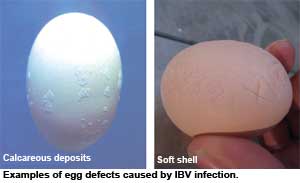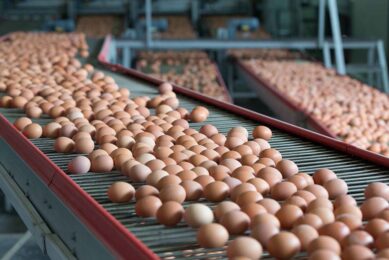Early IBV protection is essential in parent stock

Infectious Bronchitis Virus (IBV) is a highly contagious, acute disease that can have a significant effect on egg production and egg quality. IBV is increasingly seen as a cause of poor peak production, egg quality, hatchability and economic performance in breeder flocks. It is, therefore, important that procedures are put in place to ensure adequate protection against infection from IBV.
By Rik van den Bos, Veterinarian Aviagen, UK
IBV is a highly contagious respiratory disease whereby transmission via surface contamination of the egg with faeces is possible. IBV can replicate in tissues of the respiratory and intestinal tracts, kidneys and oviduct, and is periodically shed in nasal excretions and faeces for up to 20 weeks after clinical recovery. Incubation is 18-36 hours, depending on the infectious dose and route of infection. The virus spreads rapidly and although all birds in a flock will become infected, mortality is dependant on: virus serotype; age of the birds; immune status (maternal, active or influence of immunosuppressive diseases); environmental stress e.g. ammonia levels, and; other respiratory viruses and bacterial infections.
Most serotypes of IBV are inactivated after 90 minutes at 45ºC. During the winter months the virus can survive for up to 50-60 days, and in faecal material survival up to 100 days is possible. IBV is sensitive to commonly-used disinfectants, but for disinfectants to be effective all organic material, especially faeces, must be removed during clean out.
Clinical signs
Being a respiratory disease, gasping, coughing, sneezing, tracheal rales and nasal discharge are the most common and obvious clinical signs. Wet eyes and swollen sinuses may also be seen. Birds appear depressed, and feed consumption is reduced. Mortality is mainly caused by secondary bacterial infections. The disease can last for up to 10 days, but may last longer if a severe bacterial infection is present. Breeders infected with a serotype affecting the kidneys may recover from the respiratory symptoms but tend to develop ruffled dirty feathers with frequent flushing and consequential wet litter due to increased water intake.
In adult breeders the clinical respiratory signs are often accompanied by a decline in egg production. Two scenarios are commonly seen. The first is the classical egg production curve with a 10-15% drop in production after peak (declines of up to 40% may occur). The second is the absence of a clearly defined peak. Instead, a flat plateau after 40-60% production occurs (Figure 1). This type of decline is becoming more common. In both cases, however, egg production slowly increases within eight weeks of recovery from infection, but normal production levels are rarely recovered.
False layers
A change in external and internal egg quality is frequently observed. Eggs are typically smaller in size and pale to the point of some being completely white. Eggs may also be soft-shelled, misshapen or have calcareous deposits. Internally, the albumin may become thin and watery with no clear distinction between the thick and thin albumin.
Recently in Europe, Asia and the Middle East there have been concerns over the infection of young female parent stock with IBV. In these situations, otherwise healthy birds with good body-weights and Coefficient of Variations (CVs, %) do not reach peak production. Post mortem analysis reveals an incomplete or absent oviduct, or the presence of a thin walled cystic oviduct. These birds are commonly referred to as ‘false layers’ because they visit nests regularly and physically cannot be differentiated from normal layers.
Biosecurity and hygiene control
The highly infectious nature of the virus combined with the long shedding period and the possibility of carrier birds means a high biosecurity standard is essential if infection with IBV is to be avoided. The risk of flock-to-flock transmission via contamination of personnel and/or equipment is also high. A high biosecurity standard that controls the movement of personnel and equipment, and preferably an all-in all-out farm system with proper cleaning and disinfection of the houses is necessary. Proper biosecurity and hygiene control on a multi-age site, however, is very difficult.
Live and inactivated vaccines
Vaccination, which can be live or inactivated, will offer further protection against IBV. Live vaccines replicate in the respiratory tract stimulating local and systemic immunity. Inactivated vaccines help to stimulate uniform and persistent titres, but do not stimulate local, cell-mediated immunity as effectively as vaccines containing live virus. Inactivated or killed vaccines are administered by injection around 18 weeks of age. For maximum efficiency, the birds should be primed with a live vaccine at least five weeks before the inactivated vaccine is administered.
For vaccination against IBV to be effective the following are important:
• Appropriate vaccine storage and transport. Monitor storage conditions, keep the vaccine refrigerated, prevent direct sunlight and administer before expiry date.
• Application and uniform intake. Use proper and clean equipment for spray vaccination. Use clean water as well as clean waterlines for water vaccination. Always adhere to the recommendations of the pharmaceutical company.
• The development of an effective immune system in the chick is also important for protecting against IBV. Optimal brooding, ventilation and nutrition will aid the development of the immune system.
Vaccination programmes
Establishing the correct vaccination programme can be difficult due to the number of different IBV strains that exist. However, antibodies produced to one variant often show (part) cross protection to other variants. Where prevalent strains in an area have been identified, designing a vaccine programme using a commercially available vaccine is often possible.
No combination of IBV vaccine strains provides full protection against all the different IB challenges, although there are combinations that broaden the coverage. It is advised that the vaccine programme include the use of two different IBV vaccines. It is not recommended, however, to vaccinate with multiple live variant IBV serotypes, as this can lead to the development of poor immunity and excessive vaccine reaction. It is possible to vaccinate with a combination of a classical strain and a variant strain when challenge in the area is very high.
Preferably, other live respiratory vaccines should not be administered within two weeks of live IBV vaccine administration. Respiratory viruses compete for the same receptor sites on the upper respiratory mucosa affecting the antibody response. It is recommended to administer a Newcastle Disease vaccine in combination with an IBV vaccine in areas with high Newcastle challenges.
Treatment with antibiotics
Antibiotics will have no effect on the IB virus itself. However, as IBV causes a deficiency in non-specific immunity and increases the risk of a secondary bacterial infection, the use of a broad spectrum antibiotic is appropriate. Smaller spectrum antibiotics could be used to treat infections once the bacteria involved has been established.
Monitoring
Monitoring vaccine response should form a part of the vaccine programme. Blood for ELISA testing can be collected on a regular basis to monitor the mean titre response and the coefficient of variation (CV). This will give information about the immune response of a flock after vaccination, as well as the variability of that response.
Titre values may vary according to the type of bird, the age of the bird, the vaccine type used, as well as the vaccination programme.
The use of blue dyes is recommended to monitor vaccine intake after water vaccination by tongue stain scoring. It also helps to stabilise the water and will reduce chlorine and sometimes heavy metals. Every company should establish their own baselines for mean titre and CV. Auditing of the entire vaccination process should be done on a regular basis.
Considerable impact
The presence of IBV within a flock can have a considerable impact on the economic performance of the current and subsequent flocks. It is essential that adequate biosecurity (of personnel and equipment) and appropriate vaccination programmes are in place if infection with IBV is to be avoided.
Key management focus points • IBV is caused by a corona virus that is easily spread within and between flocks. This virus is very hardy and survives well in the environment. • IBV is not known to be a risk to human health. • IBV affects birds of all ages and is present worldwide. • IBV is highly infectious, only a few virus particles can start an infection. • Transmission is via direct and indirect contact between poultry and poultry premises. People, vehicles and equipment can spread the virus. • Placing chicks on farms that have not been cleaned and disinfected properly, or on built-up litter, increases risk of an IBV challenge. • Multi-age premises pose a high risk of transmission and infection of IBV. • The development of a strong immune system in the young chick is vital to IBV protection. Achieve early body-weight gains with good uniformity. • Feed good quality diets with the recommended levels of protein and vitamins to ensure proper development of the immune system. • High biosecurity standards will prevent immunosuppressive diseases e.g. Chicken Anaemia Virus (CAV), Infectious Bursal Disease (IBD), Reo Virus and mycotoxins, which may increase the severity of IBV infections. • Other respiratory challenges e.g. Turkey Rhinotracheitis (TRT), Avian Influenza (AI), Newcastle Disease (ND) and Infectious Laryngotracheitis (ILT) must be effectively controlled as well. • Vaccinations done in the first weeks of life must be achieved with minimum stress levels to the chicks. In the hatchery the route and accuracy of vaccination are important. • The vaccine programme should include the use of two different IBV vaccines. • Vaccination must follow standard operating procedures, incorporating proper vaccination techniques to prevent trauma and secondary bacterial infections. • Monitoring the presence of IBV strains in the field will help determine the strains to be incorporated into a vaccination programme. Select vaccine strains that will be most effective against the field strains present in a region. |
Join 31,000+ subscribers
Subscribe to our newsletter to stay updated about all the need-to-know content in the poultry sector, three times a week. Beheer
Beheer








 WP Admin
WP Admin  Bewerk bericht
Bewerk bericht